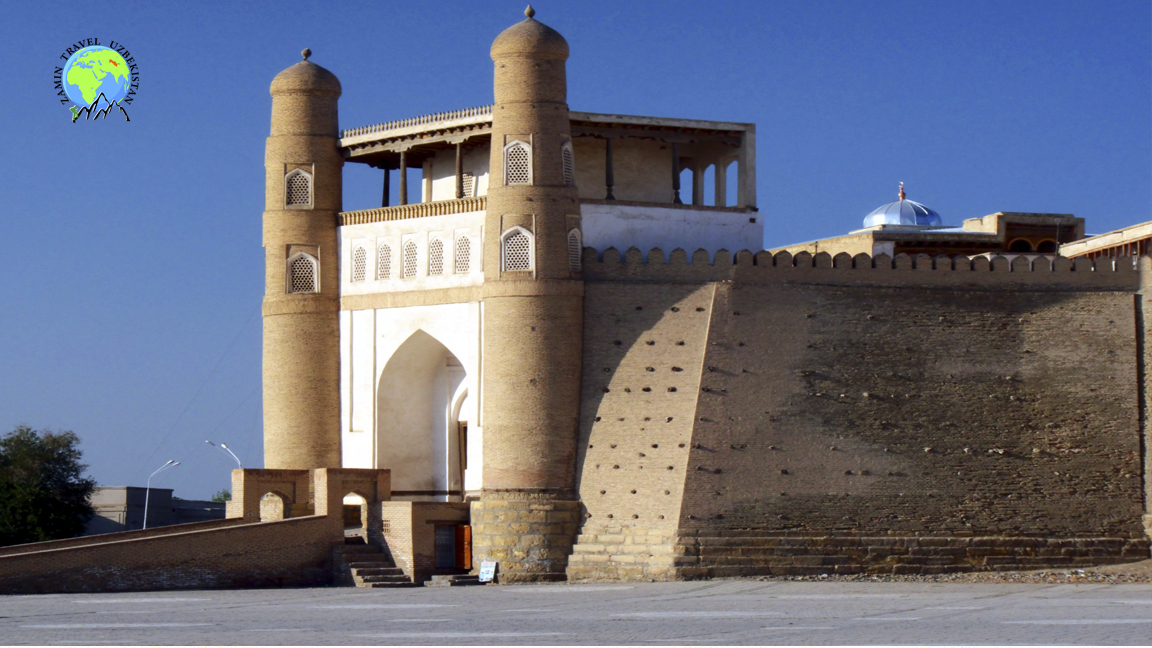


The Fortress of the Arks is the residence of the Bukhara Chans and then the Emir. It is the oldest monument in Bukhara. The Fortress of the Arks remained the main residence of the emir for many centuries, a symbol of greatness, power and impregnability. The buildings in the fortress today were constructed in the late 18th to early 20th centuries. Today Ark is a large earthen bump that resembles an irregular rectangle and is somewhat elongated in the direction from west to east. The main entrance of the Ark is architecturally designed in the form of two column-shaped towers, the upper part of which is connected by galleries, over which a room with terraces is built. The entrance to the Tor des Arkes is a ramp (Tachtapul), which is fenced in on two sides by massive stone railings. The ramp is about 20 meters long and a large leather whip (a symbol of the power of the emir) hangs on one of the walls. From the gate begins a long dark corridor (dolon), where to the left and right there are rooms for water, sand and several cells for prisoners in which the famous writer Sadriddin Aini languished. A large building complex is located in the Ark. The eastern half is currently an archaeological site. As the Ark becomes the core of the feudal city, it housed a palace, a government office, a prison, a treasury and a temple. Hence the highest government in the country. West of the Ark, Registan Square, the once booming public center of the city, was built in the pre-Arab period. By the 13th century it was occupied by administrative buildings of divans (ministries) and palaces of the nobility and later filled the bazaar buildings. In front of the entrance to the Ark there was an arsenal, weapons workshops, the reception room of the commander-in-chief of the military, as well as a large Poynda mosque, quarter mosques, butcher's madrasah, Bozori Gusfand and Dorul-shifo-madrassa, in which future doctors were trained, with a hospital - and ambulance departments. There was also a trade in grain, meat, haberdashery, tea, paper, ink, cradles for newborns, cattle, watermelons, melons, wooden utensils and other goods. In relation to the Ark - an irregular rectangle that is slightly elongated from west to east: the length of the walls is 789.6 m, the area 3.96 hectares. The height of the Registan Square ranges from 16 to 20 m. The lofty entrance door to the Ark is adorned with a portal with a gallery (Nagorahona), which was built in the 17th century. A makom cycle was carried out here during the day, after which the residents counted down the time. The entire area of the Ark can be divided into two parts: West and East. The eastern half is now an archaeological site and is closed to visitors. The ark included: the emir's house, a mosque, a harem, a Salomhona building, utility rooms, warehouses for clothes, carpets, dishes, treasures, bedding, an emir's personal protective barrack, living quarters, an arsenal, a jewelry workshop, mint. Dolon leads to the Jami Mosque, which was rebuilt as a large quarter mosque in the 18th century: a four-pillar winter hall surrounded by a three-sided aivan. Interior decoration is typical of the XIX - early XX centuries. The brightest part of the mosque is a mihrab niche and a wooden ceiling divided into caissons. The last repair here was made in 1910-1920 with the participation of the Uzbek national champion Usto Shirin Muradov, who used ganch carving. This mosque is now home to the Museum of the History of Calligraphy, which presents unique exhibits from manuscript books. The Ark was the primary residence of the rulers of the Emirate of Bukhara until 1920 (before the establishment of Soviet power), and today this majestic historical monument is a state museum reserve.